Acacia decurrens



Smooth
Bark that has a smooth texture and may be covered in lenticels.
Small dome / Mallee
A shrub to small tree with a rounded crown and with or without multiple trunks.This tree has an upright smooth greyish trunk with spreading branches that form a rounded crown. It has dark green divided ferns-like leaves and the small ball-shaped, golden yellow flowers appear in a cluster during spring.
Acacia decurrens Willd. is naturally found on the east coast and tablelands of New South Wales, Australia growing in open dry sclerophyll forest and along gullies commonly on river embankments and in heath, from sea level to an altitude of 900 m (2,952 ft) or more. It has also naturalised in other states of Australia and overseas including Hawaii, New Zealand, South Africa and Mediterranean Europe where it is regarded as an environmental weed. It grows in moist but well drained, poor to fertile sand-stony to shale based clay loam that is acidic with a pH range from 5.0 to 7.0. It prefers a protected sunny position but will tolerate some shade and is drought and frost tolerant with a preferred minimum winter temperature of 5ºC (41ºF).
The Early Black Wattle is grown for its dense crown and its profuse fragrant yellow flowers. It is planted in parks and gardens along borders as a quick screen or as a windbreak. It is also grown as a small shade tree that attracts birds, insects or butterflies and the timber is used for fire wood. It establishes in 2 to 4 years and lives for 8 to 10 years. The flowers are used in floral arrangements and the tree is excellent for new gardens with its quick growth rate but care should be taken as under ideal conditions it self-seeds and may become weedy. It has a low water requirement once established. (Scale: 1-drop from 3) preferring organic rich moist to dry sandy or clay soil and will tolerate prolonged dry periods.
I.D. 289
UK hardiness zone H2
Climate zones 8, 9, 14 - 24
USDA Zone 9-10
Acacia (a-KAY-see-a) decurrens (DE-Kur-enz)
Etymology
Genus: Greek - Acacia – from ‘akis’ - (a sharp point) referring to the thorns or the Egyptian thorn ‘akakia’ a species of Acacia that produces gum Arabic
Species: Latin – decurrens – from ‘decurrent’ meaning (running down the stems) referring to. the continuation of the rib on the underside of the petiole onto the branchlet.

Australia, (New South Wales)
Fabaceae (fab-AY-see-ee)
subfamily Mimosoideae
Wattles
This family consists of trees or shrubs primarily consisting of the Acacia genus in Australia.
Distribution
These plants are found in tropics to temperate climate zones with 3,000 species worldwide with 700 species in Australia.
Diagnostic features
The leaves may be compound (bipinnate) or reduced to phyllodes, normally having stipules and commonly arranged alternately.
The inflorescence is a raceme, spike or in heads that are terminal or axillary.
The tiny flower is normally bisexual but sometimes unisexual and is composed of 4 to 5 petals that may be imbricate. The conspicuous stamens may number the same as the sepals or be more numerous and are unfused or fused and may be attached to the base of the corolla tube.
The superior ovary is sessile or stalked commonly with numerous ovules and the style is normally filiform.
The fruit is a legume that is normally dry and contains many seeds.
The seeds have a tough coat and are round or kidney shaped. These seeds commonly have a bright coloured aril and have a long viability period. They require scarification before germination.
Note:
Many of these plants (mainly the 1,450 Acacia spp) have showy flowers and make good garden specimens; quick growing but short lived. These plants also produce valuable timber or the bark is used for dyes.
This plant tolerates between USDA zones 9a to 10a and grows to 12 m (50 ft)
Fahrenheit 20º to 30º F
These temperatures represent the lowest average.
Celsius -3.9º to -1.1º C

Attention
This plant was last revised on the 2/07/2019
The information displayed on this plant is based on research conducted in our horticultural library and from reliable online resources. We also make observations of the plant that we photograph, and all care is taken to ensure the details are correct.
All photographs and data are covered by copyright. Apart from any fair dealing for the purpose of private study, research, reference or review, as permitted under the Copyright Act, no part including images and text may be reproduced by any means without written permission. The information presented in the map is only indicative and may contain errors and omissions. All inquiries should be addressed to sales@plantfile.com attention Peter Kirkland.

Compound
The leaf that is divided into separate units (leaflets).
Bipinnate
A compound leaf that secondary leaflets arise along secondary mid ribs.
Alternate
Leaves are arranged alternately along the stem.
Entire
A leaf margin with no irregularities (smooth).The dark green bipinnate phyllodes are up to 150 mm (6 in) long and have up to 13-pairs of pinnae that are up to 70 mm (2 2/3 in) long. Each having 15 to 45 pairs of linear pinnules that are up to 15 mm (2/3 in) long. The petiole is up to 30 mm (1 1/8 in) long and the phyllodes are bright green when young becoming dark green with age.

Tubulate
A flower that forms a tube shape.
Cluster or Fascicle
A general term describing flowers that are arranged in closely packed bunches.| Jan | Feb | Mar | Apr | May | Jun |
| Jul | Aug | Sep | Oct | Nov | Dec |
There are 20-30 bright yellow flowers arranged in a globose head that is up to 7 mm (¼ in) in diameter. There are 6-15 flower heads arranged in an axillary or terminal raceme or panicle, towards the end of the branches with a peduncle to 5 mm (¼ in) long. They appear from winter to early spring.
Note;
The bisexual tubulate flowers have 4 to 5 inconspicuous sepals and petals with prominent stamens.

Legume
This dehiscent or indehiscent fruit has one or several seeds in a unicarpellate ovary. Commonly referred to as a pod. "| Jan | Feb | Mar | Apr | May | Jun |
| Jul | Aug | Sep | Oct | Nov | Dec |
The reddish brown straight to slightly curved flattened pod is up to 100 mm (4 in) long by 8 mm (1/3 in) wide and is slightly constricted between and raised over the seeds. The hard black oval seeds are up to 5 mm (¼ in) long and are arranged longitudinally in the pod.
The Early Black Wattle is grown for its dense crown and its profuse fragrant yellow flowers. It is planted in parks and gardens along borders as a quick screen or as a windbreak. It is also grown as a small shade tree that attracts birds, insects or butterflies and the timber is used for fire wood. It establishes in 2 to 4 years and lives for 8 to 10 years. The flowers are used in floral arrangements and the tree is excellent for new gardens with its quick growth rate but care should be taken as under ideal conditions it self-seeds and may become weedy.
Note:
This plant is resistant to Phytophthora cinnamomi.
This plant is susceptible to Grass Yellow Butterfly, Cottonycushion Scale, Fungal Gall, Fuller's Rose Weevil, Wattle Web-covering Borer, Crusader Bug, Sooty Mold, Beetles, Green Wattle Looper and the Tailed Emperor Caterpillar.
General information on pruning Acacia species
Tolerates a light prune after flowering back to a node, remove any dead wood back to the collar. If there is insufficient light towards the base of the tree prune the crown to allow the light in. The plants tend to be easily damaged by wind or borers, and damaged material should be removed.
Before slowing during early spring pre-soak fresh seeds in heated water 13º to 18º C (55º - 64º F) for 24 hours. Seeds may require scarification.
Propagation by Seed (General)
Germination
In order for a seed to germinate it must fulfil three conditions.
1. The embryo must be alive (a viable seed).
2. The seed must have no dormancy-inducing physiological, physical or chemical barrier to germination; also the seed must be nondormant.
3. The seed must have the appropriate environmental requirements, water, temperature and oxygen.
The interaction between these requirements and dormancy is complex and may lead to different environmental requirements that avoid the dormancy of a seed.
Sowing Seeds in Containers
There are two general methods for germinating seeds.
1. Sowing seeds in a flat or germinating bed, through which seedlings are pricked-out then, transplanted into another flat with wider spacing or directly to an individual pot.
2. Sowing seeds by placing them in to flats with the appropriate spacing or into individual pots.
This method is normally carried out with medium to large seeds such as woody plants and plants that are difficult to transplant.
Seedling production normally occurs in a greenhouse / glasshouse, cold frames and on hot beds.
Method of Seed Sowing
Fine seed is sown in pots or flats that are no deeper than 70 to 80 mm. using a sterilised well-drained media (soil). Fill the container to 20 mm from the top and sprinkle sieved peat to 3 mm depth.
Press the media down level and firm with a piece of timber and then thoroughly moisten.
Mix the fine seed with washed sand and then sow thinly on the surface. These may be lightly covered with sand.
Larger seeds may be covered with media or a hole is dibbled and the seed is placed in the media.
Watering Methods
For watering you may either mist the containers from above or place the container in tepid water and allow the water to raise through the pot to the surface of the media, then drain away and do not fill to the top of the container.
Place a piece of glass over the pot and store in a protected warm environment (glasshouse).
Seeds germinate best in darkness so shade the containers if in direct sunlight.
After the seedlings have sprouted remove the glass and ease the seedlings into direct light.
When the seedlings are large enough prick them out and transplant into larger containers then place them in a shade-house to harden off.
Many seeds have different methods of seed preparation for germination such as nicking or cutting the seed coat to allow water penetration, also placing seeds in hot water and allowing it to cool off.
This is particularly important as it is softening the seed coat.
PEST
NAME
Scale Insect
Various Scale Species
ORDER
Hemiptera
Description of the Pest
Generally scales are soft bodied insects that have a hard (armoured) or soft covering to hide under. They have piercing and sucking mouth parts that are attached to the host, feed off sap and soft scales commonly producing sweet honeydew, which in turn attracts sooty mould and ants.
The adult female has a circular or oval covering depending on the species and is up to 8mm across. The first stage (crawlers) hatch and wander around the leaf surface until finding a suitable place to suck sap, normally in colonies and the smaller male is relatively inconspicuous.
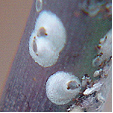 Hard Scale
Hard Scale 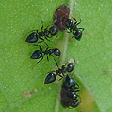 Soft Scale, attending Ants
Soft Scale, attending Ants
Cactus Scale (Diaspis echinocacti) has a circular greyish female and a narrow white male scale and is commonly found on house plants.
Chain Scales (Pulvinaria species) adult females are obvious with large group of eggs that are white or cottony-like, and the tiny young light green scales are flat and oval-shaped up to 2mm long. The legged nymphs are normally arranged from head to tail along the mid rib of the leaf, and may move to a new position to feed. They excrete honeydew and attract sooty mould and are found on Acacia and Acronychia species.
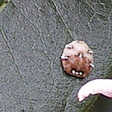 Chinese Wax Scale
Chinese Wax Scale
Chinese Wax Scale (Ceroplastes sinensis) is a domed wax scale that has dark spots around its margin and immature scales form waxy material around there margins.
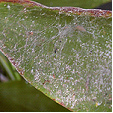 Fern Scale on Aspidistra elatior
Fern Scale on Aspidistra elatior
Fern Scale or Coconut Scale (Pinnaspis aspidistrae) appears as flecks up to 0.15mm long with a white covering over the male congregating on the underside of the fronds on the axils and among the sporangia causing them to turn yellow. Many species of fern are susceptible to infestation.
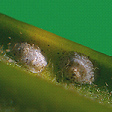
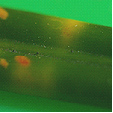 Flat Brown Scale
Flat Brown Scale
Flat Brown Scale (Eucalymnatus tessellates) are light brown up to 0.5mm long, flat and closely attached both sides of the leaf and causing yellowing of the foliage.
Juniper Scale (Diaspis carueli) is tiny and circular, white maturing to grey-black and as it feeds the needles turn yellow and die.
Oleander Scale (Aspidiotus hederae) is a pale yellow circular scale up to 3mm across and is found in dense colonies on the stem or leaves.
Tea-tree Scale (Eriococcus orariensis) are a creamy blue colour normally packed along the branches and are plump and rounded to 4mm across.
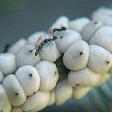
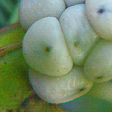 Wattle Tick Scale
Wattle Tick Scale
Tick or Wattle Scale (Cryptes baccatus) adult is domed, blue-slate colour with a leathery covering up to 10mm long. All stages of growth are found in groups of over forty, packed along the stems and normally tended by ants as they produce large amounts of honeydew. A serious pest of Acacia species found inland or coastal from temperate to sub tropical climates and commonly accompanied by Sooty Mould.
Toxic Scale (Hemiberlesia lataniae) is a tiny flat rounded scale up to 0.15mm long and is white to pale pink. It is normally found in colonies on the small branches and twigs of shrubs. It injects a toxic substance into the host as it sucks sap causing the death of the branch.
Wattle Scale (Pseudococcus albizziae) is soft, plump and secrets cotton-like threads. It is not a true scale insect and is simular to mealy bugs. It is reddish-brown up to 0.4mm long and secrets large amounts of honeydew as it sucks sap in colonies along the branches.
Life Cycle
These insects have a Hemimetabolous life cycle, ie. When the immature nymphs resemble the adults.
Appearance of the Pest
All parts of the plant above the soil may be attacked, but normally the stems and leaves and scale tends to favour well-lit positions.
Period of Activity
The nymphs and females are active for most of the year, in warm climates. Once they selected a position they attach and don't move. Normally the winged or wingless males are mobile and only soft scales produce honeydew.
Susceptible Plants
There is a wide range of susceptible plants including citrus, willows, holly, and many ornamentals, such as roses or Paeonia species. It also attacks indoor or glasshouse plants and Australian native plants such as wattles, hakeas, grevilleas and eucalyptus.
Acacia species are attacked by the Tick or Wattle Scale, which infest twigs and small branches and heavy infestations will kill the host plant.
Acer species are attacked by the Cotton Maple Scale (Pulvinaria innumerabilia) which prefers Acer saccharinum. Nymphs first attack the leaves and the brown adult scale is covered in a woolly mass up to 14mm across, normally found on the underside of the stems and twigs.
Acmena smithii, Melaleuca, Syzygium and Pittosporum species are attacked by the Chinese Wax Scale.
Aesculus species are attacked by several scale insects including the Walnut Scale (Aspidiotus juglans-regiae) which is saucer-shaped and attacks the main trunks.
Agave species are susceptible to several types of scale including (Aspidiotus nerii), (Aonidiella aurantii) and (Pinnaspis strachani), but generally do not require control.
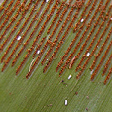 Asplenium australasicum
Asplenium australasicum
Asplenium australasicum is susceptible to Coconut Scale or Fern Scale (Pinnaspis aspidistrae). It is normally found on the under side of the fronds. Small infestations cause little damage.
Bougainvillea species may be attacked by the soft scale (Coccus hesperidum) outdoors or under glass.
Calluna and Vaccinium species are attacked by the Oyster Shell Scale (Lepidosaphes ulmi).
Camellia species may be attacked by the Florida Red Scale (Chrysomphalus aonidum), which is small, circular and black and is found firmly attached to the underside of the leaf along the veins. On inspection after removing the scale the insect has a pale yellow body. Camellias are also attacked by a large variety of scale insects including Tea Scale and Camellia Scale.
Carpinus species may be attacked by the scale (Phenacoccus acericola). It is found on the underside of the leaves forming a white cotton-like clump along the veins.
Casuarina and Allocasuarina species may be attacked by the Casuarina Scale (Frenchia casuarinae), a black hard scale that is upright to 4mm with a pinkish body. During attachment the surrounding tissue swells up and in time can, form galls. This weakens the wood and in severe infestations may kill the tree.
Cotoneaster species are attacked by up to four species of scale including the Oyster Shell Scale (Lepidosaphes ulmi).
Cupressus species are attacked by Bark Scale (Ehrhornia cupressi) is pink and covered in white wax. Heavy infestations cause the leaves to turn yellow or reddish.
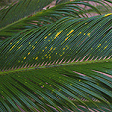 Flat Brown Scale on Cycas revoluta
Flat Brown Scale on Cycas revoluta
Cycads, palms and some species of Callistemon are attacked by the Flat Brown Scale.
Erica species are attacked by several species of scale including, Greedy, Oleander and Oystershell scale.
Jasminum species can be infested with up to twelve types of scale.
Juniperus x media and other conifer species are attacked by the Juniper Scale.
Leptospermum species are attacked by the Tea-tree Scale which produces ample honey dew that promotes sooty mould.
Palm and Fern species are susceptible to attack by the Coconut Scale or Fern Scale (Pinnaspis aspidistrae) which infests the underside of the leaves. They are also hosts for many other scale species such as red, cottony cushion and tea scale.
Pinus species are attacked by several species of scale including the Pine Tortoise Scale (Toumeyella numismaticum) and the Red Pine Scale (Matsucoccus resinosae).
Polygonum odoratum is attacked by a small brown scale.

Sorbus aucuparia is attacked by a five species of scale insect, including Black Cottony Maple, San Jose and Scurfy. Generally they suck on the sap of the new growth and leaves.
Strelitzia species are attacked by the Greedy Scale (Aspidiotus camelliae).
Damage Caused
Leaves become yellow and are shed prematurely and there may be twig or stem die-back. When the infestation occurs on fruit, the fruit is small and its skin becomes pitted and cracked. Small trees and saplings that are heavily infested may be seriously damaged or die. Sooty mould can cover fruit or leaves causing a secondary problem.
Cactus Scale can completely cover the host cactus sucking sap and causing it to die.
Cultural Control
Dead or damaged parts of the plant should be removed and destroyed including fallen fruit. Small infestations may be removed by hand or squashed on the stems. Healthy plants are less susceptible to attack, so maintain vigour of the plant and avoid using high-nitrogen fertiliser that produces excessive soft young growth.
When pruning susceptible plants paint the cuts with antifungal sealant paint as scale insects are attracted to the sweet smell of the sap. This will reduce the infection rate of the plant.
Biological Control
Natural predators such as parasitic wasps may reduce numbers of active nymphs; parasitic wasps are bred commercially in some areas for this purpose. It should be noted, however, that wasps would avoid dusty conditions.
Other predators that assist in control are assassin bugs, ladybirds, lacewings, hover flies and scale eating caterpillars. A variety of birds also attack scales.
The control of ants that transport aphid from one host to another also reduces infestation and can be carried out by applying at least three greased bandages 5mm apart around the stem or trunk of the plant.
Chemical Control
Spray the entire plant with dilute white oil solution; a follow-up spray may be required after four weeks, for heavy infestations. Spraying of chemicals will also kill of natural predators and in some cases the secondary scale infestation is more prolific especially when using copper based chemicals.
Some chemical controls, such as methidathion, are available - please seek advice from your local nursery as to the suitable product for your area.
Note
Always read the label for registration details and direction of use prior to application of any chemicals.
PEST
NAME
Wattle Blight
Paropsis orphana
ORDER
Coleoptera
Description of the Pest
This is a small rounded beetle that is light green with white stripes and the larvae are fleshy, greenish and tapering towards its tail. Both grow to a length of 6mm and have chewing mouth parts.
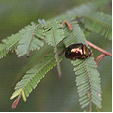
Appearance and Distribution of the Pest
The adults appear during the warmer months of the year and are commonly found in temperate regions. The larvae are found close to stems where they are well camouflaged.
Life Cycle
This insect has a Holometabolous life cycle, ie. When metamorphosis is observed during the pupal stage.
Under good conditions the insect numbers increase dramatically.
Period of Activity
From spring to summer.
Damage Caused
Larvae and adults graze on the surface of leaflets causing the leaves to turn brown and die. This gives a tree a scorched appearance and can be a serious problem in mono cultures
Susceptible Plants
Many Acacia species are attacked particularly feather leaved types such as Acacia dealbata and Acacia decurrens.
Cultural Control
Difficult to control, small populations may be removed by hand.
Biological Control
Birds and wasps may help in reducing numbers.
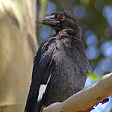 Currawong
Currawong
Chemical Control
Plants may be sprayed with a systemic insecticide to help control.
Note
Always read the label for registration details and direction of use prior to application of any chemicals.
PEST
NAME
Leaf Hopper (General)
Various Leaf Hopper Species
ORDER
Hemiptera
FAMILY
Eurytomidae
Description of the Pest
Generally hopper grows up to 15mm in length, with "A"-shaped folded wings that give it a characteristic triangular cross-section. The adults often have bright coloured markings and the nymphs conjugate in colonies. Adults can fly but will hop away immediately if disturbed and both nymphs and mature hoppers have piercing and sucking mouth parts.
The Passion Vine Hopper (Scolypopa australis) has clear triangular wings that have brown margins and black bands. The nymphs are wingless and white with tufts of hair on the end of the abdomen.
The Green Leaf Hopper (siphanta acuta) looks triangular with its steeply folded wings and can grow to 10mm long. The adults are generally a solitary feeder but the nymphs congregate on shoots.
Appearance and Distribution of the Pest
The adults and nymphs are present throughout the year in tropical to warm temperate regions and are dispersed by flying.
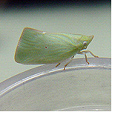
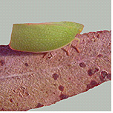
Life Cycle
These insects have a Hemimetabolous life cycle, ie. When the immature nymphs resemble the adults.
Females deposit eggs in slits they make in the bark or on the leaves of the host, and several generations may appear annually on the same plant.
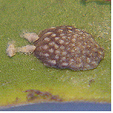 Egg and Nymph
Egg and Nymph 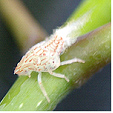
Damage Caused
Nymphs and adults are gregarious, and both stages may be found on host plants at the same time. If large numbers attack young new growth, sucking sap from leaf petioles and young stems, the host plant may become stressed. Severe infestations may weaken and eventually kill the plant with dieback and distorted leaves.
The nymphs exude a sweet secretion, which is attractive to ants that attend and protect the colony. The honeydew also causes sooty mould to occur as a secondary problem. Some species produce toxic saliva that kills the effected plant tissue; other species carry plant viruses.
Susceptible Plants
Most Eucalyptus, Acacia and Casuarina species are attacked by a variety of leafhoppers. Many other Australian native and ornamental plants are attacked.
Acer species are attacked by the leaf hopper (Alebra albostriella) which lays eggs under the bark causing minor swelling. Acer platanoides is particularly venerable.
Callistephus and Aster species are attacked by the Leaf Hopper (Macrosteles fascifrons) that generally causes little harm to the plant but transmits Yellow Disease, a viral infection.
Fern species are attacked by several types of leaf hopper, particularly the Passion Vine Hopper (Scolypopa australis). New fronds become deformed or misshapen as the insect sucks the sap causing dead patches to appear.
Parthenocissus species are attacked by the Green Leaf Hopper.
Rosa species are attacked by the Rose Leaf-hopper (Edwardsiana rosae), nymphs feed on the underside of leaves causing white blotches.
Sorbus aucuparia is attacked by the Japanese Leaf Hopper (Orientus ishidae) which causes the leaves to form a brown blotches with yellowish margins.
Cultural Control
Improving the culture of the host species may assist in maintaining vigorous growth, to minimise shock from infestations. It may be possible to remove them by hand, from young trees, using a small butterfly net if you are lucky.
Biological Control
Controlled by natural predation and the Green Leaf Hopper causes little harm and control is unnecessary.
Chemical Control
Under normal circumstances, it is impractical and unnecessary to treat mature trees however, hoppers on young plants may be treated with a contact insecticide. Note
Always read the label for registration details and direction of use prior to application of any chemicals.
PEST
NAME
Fuller's Rose Weevil
Various Rose Weevil
Species
ORDER
Coleoptera
Description of the Pest
The Fuller's Rose Weevil (Asynychus cervinus) is greyish-brown and grows to 7mm long and is found in Australia. The female adult has faint white marks on its sides and feeds on leaf margins and flower buds. It lays its eggs under loose bark or in curled dead leaves that have fallen to the ground. The light grey lava is up to 6mm long burrow down feeding on the roots, where they overwinter.
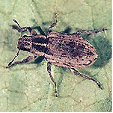
The Fuller's Rose Weevil (Pantomorus godmani) female adult is greyish-brown, up to 8mm long with diagonal white stripes across its wing covers and feeds on leaves at night. It is found in northern and southern USA. The lava feed on the roots and overwinters under ground.
Distribution of the Pest
Fuller's Rose Weevil's are found throughout the world and are distributed by walking to a new host or are transported on infested plants.
Life Cycle
These insects have a Holometabolous life cycle, ie. When metamorphosis is observed during the pupal stage.
The adult female can live up to three months during which it can lay up to ten groups of thirty eggs and the lava, can remain under ground for up to nine months before emerging as adults.
Period of Activity
The adult is most active from summer to autumn.
Damage Caused
Generally the adults chew leaves, preferring new foliage or flower buds and on mass can cause sever damage to the host. The roots are attacked by the lava and may cause yellowing of the foliage and small plants such as Lycopersicon species may be killed.
Susceptible Plants
There are many plants that are attacked by these pests, particularly broad leafed types.
Camellia, Citrus, Dahlia, Gardenia, Passiflora, Prunus, Rosa and Rubus species are susceptible to the Fuller's Rose Weevil (Asynychus cervinus).
Acacia, Begonia, Camellia, Canna, Chrysanthemum, Cissus, Citrus, Dianthus, Diospyros, Dracaena, Fuchsia, Gardenia, Hibiscus, Lilium, Pelargonium, Penstimon, Plumbago, Prunus persica, Quercus, Rhododendron, Rosa and Vinca, species.
All are susceptible to attack by the Fuller's Rose Weevil (Pantomorus godmani).
Cultural Control
Small infestations may be removed by hand at the adult stage and fallen leaves or debris should be removed from around the base of the plant. Sticky traps at the base of the plant may inhibit the adult climbing the plant.
Chemical Control
Plants may be sprayed with Carbaryl when the adults are first seen.
Note
Always read the label for registration details and direction of use prior to application of any chemicals.
PEST
NAME
Caterpillars (General)
Various species
Description of the Pest
There are many types of caterpillars from moths or butterflies, cutworms, bag moths, case moths, leaf rollers leaf skeletonises. The larvae generally eat leaves, seeds, flowers or buds by chewing out pieces. The size of the piece will depend on the size of the caterpillar and generally they are voracious eaters. The method of eating varies such as the leaf skeletoniser which leaves a network of veins or whole leaves are consumed.
The larvae have mainly 4 or 5 pairs of prolegs except Loopers which have 2 -3 pairs of prolegs. The number of prolegs can help in identifying the insect.
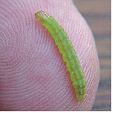 Small and Large Types
Small and Large Types 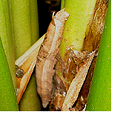
Casuarina Moth (Pernattia exposita) is gregarious, brown with a large head and tufts of hairs that line the slender body. It grows to 25 mm long and forms a tightly woven cocoon on the side of branchlets. The large female adult moth has a stocky body and generally slow moving, the male is smaller.
The larvae cause extensive damage to A. littoralis, A. stricta, C. cunninghamiana, C. glauca, and C. equisetifolia.
The hairy larva feed on the 'leaves" phyllodes, and stems, this can lead to ringbarking and death of branches.
Monitoring
Place sheets on the ground and disturb (shake) the tree for the larva drop to the ground on silken threads.
Spruce Budworm (Choristoneura fumiferana) is a reddish brown with a yellow stripe on its side and chews on the opening buds and the needles of the host. The adult moth is dull grey with brown bands and spots on the wings, appearing in early summer. The larva is very destructive in northern hemisphere coniferous forests.
Banksia Moth (Danima banksiae) is a caterpillar up to 60 mm long and is brown with black and white markings on its sides and when disturbed it arch backwards and reveal an extruded red underside, close to its head. The grey adult moth has an orange coloured body with a wing span that is up to 80mm across with black and white markings.
Banana moth (Opogona sacchari) is in the order Lepidoptera. This nocturnal moth as a wing span up to 25 mm wide and is bright yellowish brown with a dark brown spot on the wings. It has a life cycle that lasts approximately 3 months with the eggs hatching in 12 days and the whitish larva with a reddish brown head is up to, 26 mm long, and lives for 50 days at 15° C. In warmer climates life cycle is quicker with up to eight generations per season. The female moth uses a ovipositor to lay up to 500 eggs in groups of five amongst the crevices of the plant. The voracious larvae tunnel into the plant, avoiding light. In bananas it infests developing fruit and in ornamental plants it prefers the fleshy stems, particularly in cacti, begonias, African violets and is also a serious pest of Pritchardia and Chamaedorea species. Symptoms include tunnelling activity, which may be difficult to see then dead areas appear on the stems. As the caterpillars destroyed xylem tubes leaves begin to wilt and the plant may collapse and die. In European countries it is a glasshouse pest that is controlled chemically.
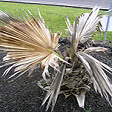 Pritchardi species
Pritchardi species 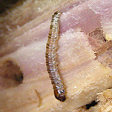 Banana moth larvae
Banana moth larvae
European Pine Shoot Moth (Rhyacionia buoliana) lays eggs on Pinus species during late spring on the new buds and the emerging caterpillars in late summer feed on the shoots causing them to fold and become deformed, eventually dieing. A major problem in the pine forests of the northern hemisphere
Large Grass Yellow Butterfly (Eurema hecabe) is a small attractive yellow butterfly. with a wing span of 40 mm that lays its eggs on the feathery leaves on Acacia species such as A. baileyana, (Cootamundra wattle), A. spectabilis (glory wattle). Other plant foods include Cassia spp, Caesalpinia spp, Senna spp. Albizia julibrissin (silk tree) A. paraserianthes (Albizia) sp Aeschynomene sp (Budda pea), Indigofera australis (Australian indigo's), Sesbania cannabina (yellow pea-bush), Senna surattensis (Glossy shower), Leucaena leucocephala (wild tamarind).
The small lava are up to 15mm long, green with white lateral bands and feed on the leaves at night in small groups, hiding under the leaves during the day. Large infestations may strip trees and require control. The larva of this insect does not feed on grasses. The adults are important pollinators of many Australian native plants. Various sub species of this insect are found through out Asia.
Gypsy Moth (Porthetria dispar) lava is a hairy grey caterpillar that is marked with blue and red dots along its back and can grow to 75mm long. It is capable of defoliating large trees and is a major problem for several species. A major problem in the northern hemisphere.
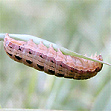 Lawn Armyworm
Lawn Armyworm
Lawn Armyworm (Spodoptera mauritia) is a plump, smooth caterpillar that is darkish brown to black with multiple stripes and pattens along its body. It can grow to 50mm long and tapers from the head. They are gregarious and move around in groups, like an army. If disturbed the larva drop to the ground and curl up, "faking death" The larva pupate in the soil. They are a pest of grasses and monocotyledon crops mainly.
This insect is also found throughout Asia.
Monitoring
Drench a known area with old fashion soap 2L / 1000 cm 2. Note the numbers of larvae emerging.
Oblique-banded Leaf Roller (Choristoneura roseceana) lava feeds on the leaves and forms a nest by drawing the leaf margins together using silk threads. The adult moth is up to 25mm across the wingspan and is reddish brown with three darker brown bands across the wings. This is a problem in the apple growing areas of North America. It feeds on Maples, hawthorns, crab apples, Blackberry (bramble) and raspberries.
Red Humped Caterpillar (Schizura concinna) is a lava has a red head and humps with yellow and black strips on the body. It grows from eggs that were laid on the underside of leaves by the adult greyish brown moth that has a wing span up to 30mm across.
Tailed Emperor Caterpillar (Polyura pyrrhus spp. sempronius) adult is a large butterfly with a wing span up to 110 mm with four long tapering tails and the rear of the wings. The fleshy caterpillar with four obvious backward facing horns on a shield shape head. It is dark green with yellowish bands and transversal stripes over its back and grows up to 80 mm in length.
It is commonly found solitary or in small groups. Found over much on mainland Australia. The adults are attracted to overripe fruits they become drunk on this and so are easy to capture. The larvae feed on many plants including, Acacia baileyana (Cootamundra Wattle, A. spectabilis (Glory wattle), Delonix regia (Poinciana), Cinnamomum camphora (Camphor laurel) Robinia pseudoacacia (Black or false locust) Lagerstroemia indica (Crepe Myrtle), Argyrodendron actinophyllum (Black booyong), Celtis spp (Hackberry), Brachychiton spp (Kurrajongs) Gleditsia triacanthos (Honey locust).
Verbena Moth (Crambodes talidiformis) lays its eggs on the outside of the plant and the small green caterpillar that attacks seed pods by entering and eating the contents. It half emerges while pupating appearing as a small brown bump circled by a black ring. Native to North America
White Tussock Moth (Hemerocampa leucostigma) produces lava that is up to 50mm long. It has a red head with a yellow body that is marked in black and has four tufts of hair. The caterpillars pupate on the branches and the eggs laid by the adult moth overwinter on the trunk and are covered in a white waxy material. They are found on Aesculus species. A pest in North America of Oaks.
Life Cycle
This insect has a Holometabolous life cycle, i.e. it has a larval and a pupal stage.
Distribution of the Pest
Many species are found throughout the world from tropical to temperate regions and most of the adults are capable of by flying
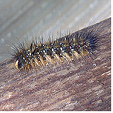 Many hairy caterpillars can be irritating
Many hairy caterpillars can be irritating 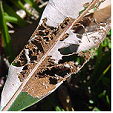 Leaf Skeletonised
Leaf Skeletonised
Period of Activity
Most active during the warmer months from spring to autumn.
.
Damage Caused
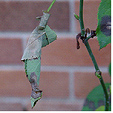 Leaf Rollers
Leaf Rollers
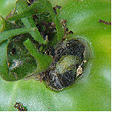 Caterpillar Inside a Tomato
Caterpillar Inside a Tomato
Susceptible Plants
A wide range of native and exotic plants are attacked and can be a major problem in commercial crops or turf grasses. Plants with soft-textured foliage (eg vegetables, some indoor plants) are preferred, but trees and shrubs are commonly attacked.
Malvaceae Abutilon spp, Hibiscus spp and other members of the family are attacked by the castor oil looper, Croton caterpillar (Achaea janata) which feed on leaves. The tip borer Cotton tipworm (Crocidosema plebejana), Rough bollworm (Earias huegeliana) which feeds on young stems, flowers and seeds. A leaf miner (Phyllonorycter spp)
Acer saccharinum and Fagus species are attacked in North America by the Maple Leafcutter (Paraclemensia acerifoliella) that forms a small cocoon in leaves that it skeletonises.
In Australia Case moths and Painted apple moths (Teia anartoides)
Ailanthus altissima is attacked by the Cynthia Moth (Samia cynthia) light green lava, which eats leaves and the Ailanthus Webworm (Atteva aurea) which are olive-brown caterpillars that form web nests in the leaves.
Antirrhinum species are attacked by the Leaf Tier (Udea rubigalis) lava. This caterpillar eats pieces out of leaves and binds them together forming a nest. It is more commonly found in glasshouse culture.
Berberis species may become infested with the Barberry Worm (Omphalocera dentosa). This small caterpillar is black with white spots, up to 14mm long and feeds on young shoots and leaves. It also binds the shoots with a silken thread to form a nest.
Betula species are attacked by the Leaf Skeletonizer (Bucculatrix canadensiella). The small adult moth has brown wings with a whitish underside and its yellow green, 7mm long lava skeletonise the undersides of the leaf turning it brown.
Brachychiton, Senna and feathery-leaved Acacia species are attacked by the Tailed Emperor Caterpillar, particularly in dryer periods.
Catalpa species are attacked Catalpa Sphinx (Ceratomia catalpae). This large yellow and black Caterpillar grows to 76mm long and attacks the leaves. Large infestations can completely stripped a tree and control is carried out by spraying.
Calendula and Canna species are attacked by the Woollybear Caterpillar (Diacrisia virginica) which has yellow and black lines down its body is up to 50mm long and eats the leaves or flower buds. In Canna species the chewed holes tend to be in a straight line across the leaf.
Celtis species are attacked by the Spiny Caterpillar (Nymphalis antiopa) which is reddish, up to 50mm long and feeds on the leaves at the top of branched in groups.
Cheiranthus species are attacked by the Diamond-backed Moth (Plutella maculipennis) lava, which is a small green caterpillar to 14mm long that feeds on the underside of leaves and may form a shot hole appearance. It forms a small cocoon to pupate in and in cooler climates it may be found in glasshouses.
Cotinus, Fraxinus, Betula, Cornus, Crataegus, Aesculus, Tilia, Acer, Quercus and Populus species are susceptible to attacked by the Oblique-banded Leaf Roller (Archips rosaceana)
Iris and Antirrhinum species are attacked by Verbena Moth.
Picea, Abies, Tsuga and Pinus species are attacked by Budworm commonly found in the northern hemisphere.
Populus and Carya species are attacked by the Red Humped Caterpillar which chews the leaves.
Quercus species are attacked by several caterpillars including Saddleback Caterpillar (Sibine stimulea) and Datana Caterpillar (Datana ministra) that feed on the leaves.
Samanea saman is attacked by several caterpillars (Ascalapha odorata, Polydesma indomita and Melipotis indomita). These caterpillars defoliate the tree but cause no long term problems.
Spiraea, Fraxinus, Betula, Cornus, Crateagus, Acer, Quercus and Populus species are attacked by the Oblique-banded Leaf Roller.
Ulmus, Salix, Crateagus, Tilia, Quercus and Populus species, Pseudotsuga menziesii are attacked by the Gypsy Moth (Porthetria dispar).
Ulmus species are attacked by the Spring Cankerworm (Paleacrita vernata), which chews the leaves during spring and the Fall Cankerworm (Alosphila pometaria), which also eats the leaves during autumn. Ulmus species are also attacked by several caterpillars including the lava of the Leopard Moth (Zeuzera pyrina) and the Tussock Moth (Hemerocampa leucostigma).
Cultural Control
Small numbers may be removed by hand and squashed while others species such as the Casuarina Caterpillar drop to the ground when disturbed by hitting with a stick or shaking the plant. On the ground they can be squashed or collected and placed in a bucket of soapy water. All rubbish around plants and glasshouses should be cleared as certain moths overwinter in such places.
Biological Control
There are many natural predators that reduce numbers including birds, lizards, frogs; other predators are wasps, viruses, and fungi.
Chemical Control
The small plant may be sprayed using Pyrethrum-based insecticide to reduce numbers or dusted with an equally environmental friendly chemical. In severe cases crops may be sprayed with Carbaryl.
Note
Always read the label for registration details and direction of use prior to application of any chemicals.
PEST
NAME
Looper Caterpillars
Various Looper Caterpillar Species
ORDER
Lepidoptera
FAMILY
Noctuidae
Description of the Pest
The looper is so-called because of the larvae's characteristic "looping" movement: the back legs move forward behind the front legs, causing the body to arch into an inverted "U" shape. They vary in colour and size; Brown Looper (Lophodes sinistraria) can grow to 50mm long, glossy black with yellowish bands then maturing to brown and found in coastal sub-tropical regions.
Green Wattle Looper (Thalaina species) adult is a small white moth with a wing span of 40mm and the lava is a slender green caterpillar with a rounded head. It is commonly found on ferny leaves Acacia species and when it is not feeding it takes up an erect position imitating a twig growing at an angle. It is difficult to detect and normally not requiring control.
Grevillea Lopper (Oenochroma vinaria) is a slender caterpillar that is greyish with orange bands and has two thorn-like projections on its back towards the head that it uses in a defence position. It is hairless with mottled orange colouring and grows to 80mm long. The adult moth (pink belly moth) has a wing span up to 60mm across and is pinkish.
Brown Looper (Lophodes sinistraria) are black with yellowish bands at first maturing to brown growing to 50mm long. It is a solitary feeder eating mature leaves and are found in tropical to sub tropical regions.
Appearance and Distribution of the Pest
Many species are found throughout Australia from tropical to temperate regions.
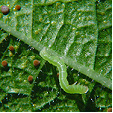
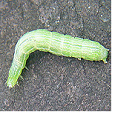
Life Cycle
These insects have a Holometabolous life cycle, ie. When metamorphosis is observed during the pupal stage.
Period of Activity
Most active during the warmer months the larva feed generally in the early morning or in the evening. Caterpillars are also active during cloudy days.
Damage Caused
Larvae are voracious feeders, skeletonising leaves or stripping them to the midrib preferring new growth.. Certain species feed solitary while others in groups.
The Grevillea Lopper feeds solitary or in groups defoliating small areas in species such as Lambertia and Grevillea.
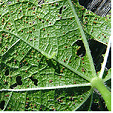
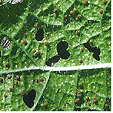
Susceptible Plants
A wide range of native and exotic plants are attacked, depending on the species of looper. Plants with soft-textured foliage (eg vegetables, some indoor plants) are preferred. The Brown Looper is found on Acmena smithii, Waterhousea floribunda and Macadamia species.
Tropaeolum and Calendula species are attacked by the Cabbage Looper (Trichoplusia ni), which feeds on the leaves and flowers.Tropaeolum species are also attacked by the caterpillar (Pieris rapae), which eats the foliage.
Cultural Control
Small numbers may be removed by hand.
Biological Control
Birds and other predators reduce numbers.
Chemical Control
The plant may be sprayed using Carbaryl. During heavy infestations this method is effective.
Note
Always read the label for registration details and direction of use prior to application of any chemicals.
PEST
NAME
Gumtree Hopper, Jassid
Eurymela Species
ORDER
Hemiptera
FAMILY
Eurymelidae
Description of the Pest
Generally the gumtree hopper grows up to 12mm in length, resembling a small tiny cicada, and its "A"-shaped folded wings give it a characteristic triangular cross-section. The nymphs are orange, with blue markings, while the adult hopper is black or dark blue, with small white spots on its wings. Adults can fly but will hop away immediately if disturbed. Both nymphs and mature hoppers have piercing and sucking mouth parts and there are many species.
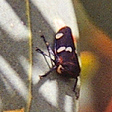 Common Jassid
Common Jassid
Image by B. Sonsie
Common Jassid (Eurymela fenastrata) adult is black with yellow or white markings on its wings, and is a specialised hopper that only feeds on Eucalyptus species.
Appearance and Distribution of the Pest
The adults and nymphs may be present throughout the year across most of Eastern Australia, and in warm climates.
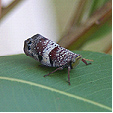
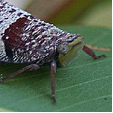
Life Cycle
These insects have a Hemimetabolous life cycle, ie. When the immature nymphs resemble the adults.
Females deposit eggs in slits they make in the bark of the host, and several generations may appear annually on the same plant.
Period of Activity
Hoppers may be active throughout the year in tropical to temperate climates.
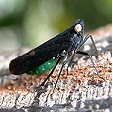
Damage Caused
Nymphs and adults are gregarious, and both stages may be found on host plants at the same time. If large numbers attack young new growth, sucking sap from leaf petioles and young stems, the host plant may become stressed. Severe infestations may weaken and eventually kill the plant. The nymphs exude a sweet secretion, which is attractive to ants; it also causes sooty mould. Some species produce toxic saliva that kills the effected plant tissue; other species carry plant viruses.
Susceptible Plants
Most Eucalyptus species and ferny-leafed Acacia species.
Cultural Control
Improving the culture of the host species may assist in maintaining vigorous growth, to minimise shock from infestations. It may be possible to remove them by hand, from young trees, using a small butterfly net.
Biological Control
Controlled by natural predation such as small birds, spiders, assassin bugs, ladybirds and lacewings.
Chemical Control
Under normal circumstances, it is impractical and unnecessary to treat mature Eucalypts; however, hoppers on young plants may be treated with a contact insecticide.
Note
Always read the label for registration details and direction of use prior to application of any chemicals.
PEST
NAME
Beetles (General)
Various Beetle Species
ORDER
Coleoptera
Description of the Pest
There are many different types of beetles both adult and larvae feed and have chewing mouth parts.
Agave snout weevil (Scyphophorus acupunctatus)
The Agave snout weevil or sisal weevil is a beetle up to 15mm long. It has a dull brownish-black body with a long protruding snout and chewing mouth parts. The adult female lays eggs at the base of the leaves where the hatching larvae feed on the succulent centre of the leaf with their chewing mouth parts and cause significant damage. Decay microbes then entre through the wounds and cause the plant to die by collapsing from the base.
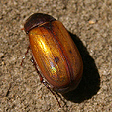
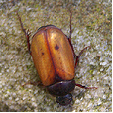 Brown (Scarb) Eucalyptus Beetle
Brown (Scarb) Eucalyptus Beetle
Brown Eucalypt Beetle (Lepidiota rothei) adult is brown with hairy legs and grows to 20mm long. It has chewing mouth parts and feeds on the leaves, sometimes swarming and stripping the host tree. The lava is cream coloured curl-grubs that feed on the roots of the tree. The feeding habits of this beetle are very simular to the Christmas Beetle (Anoplognathus species), eating new shoots and leaves to the mid rib, commonly attacking Eucalyptus species.
European Bark Beetle (Scolytus multistriatus) female adult is reddish up to 3mm long and lays its eggs in tunnels in the sap wood and the emerging lava tunnel through the bark forming tiny holes. This beetle is regarded as a main transmission source for Dutch elm disease that infects Ulmus species.
European Willow Beetle (Plagiodera versicolora) is metallic blue up to 4mm long and overwinters in the bark. During spring the yellowish eggs are laid and the emerging lava skeletonise leaves by feeding on the underside. There can be two generations per year and attack Salix species.
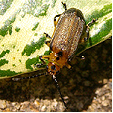 Fig Leaf Beetle
Fig Leaf Beetle 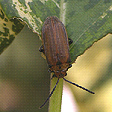
Fig Leaf Beetle (Poneridia semipullata) is a dull brown adult has a reddish brown head and growing to 12mm (¼in) long with prominent antennae. It deposits up to 50 eggs that are in groups on the underside of the leaf. The yellowish spiny larvae are small and appear as sawdust on the leaf. As they mature they turn blackish and grow to 12mm (¼in) long, widest at the head.
It prefers coastal tropical to warm temperate regions and both adult and larvae feed on the leaves. The larva graze in groups skeletonising the leaves and making plants look unsightly.
Figwort Weevils generally the adult beetles are normally black to greyish white, up to 4-5mm long with one or two black circular marks where the wing cases meet. The larvae are yellowish to brown grubs with black heads up to 6mm long and have a slimy texture.
The larvae pupate in spherical cocoons that it spins and is attached to the host stems. The cocoon resembles the seed pods of Scrophularia species (Figwort). Adults overwinter in leaf litter or the soil emerging during spring and lay eggs on the host plant. There is normally two generations per year.
The larvae feed on leaves by grazing the surface of the leaf eating the epidermal layer. The leaf turns brown, shrivels and dies. Many plants are susceptible, including Hibiscus, Dahlia, Vitis species and avocados, potatoes, sweet potatoes, rhubarb, and various weed species.
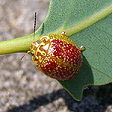
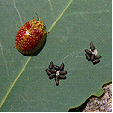 Paropsis species adult and larvae
Paropsis species adult and larvae 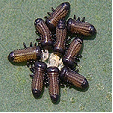
Leaf-eating Beetles in the Chrysomelidae family are found throughout the world with over 3,000 species in Australia. Generally small smooth and colourful, globular or flattened up to 15mm in length with antennae one third the length of the body. Normally adults and larvae feed on the living tissue of the leaves. There are many sub-families including Sagrinae containing the larges species, Bruchinae containing larvae that eat seeds and the larges subfamily Chrysomelinae contains many species such as Paropsis species. These beetles are characteristic dome shape and are commonly seen on Eucalyptus species.
Mountain Pine Beetle (Dendroctonus ponderosae) is a dark brown to blackish adult beetle up to 7.5 mm long. There are 4-larval stages that include a white larval with no legs that appear from vertical egg galleries and mature larval produce oval pupation cells towards the end of the tunnels in the tree. They emerge from small openings at the tunnel end as adults. This pest affects millions of hectares of forest in North America and Canada including many species of Pinus. It normally attacks older weaker trees but under ideal conditions it attacks healthy trees. Pinus albicaulis has become endangered due to the actions of this species. Numerous beetles can attack a single tree and the larval attack on the cambium layer can be accompanied with a fungal attack such as the Blue stain fungi (e.g. Ceratocystsis and Ophiostoma spp.) causing death of the tree. Symptoms include the needles in the crown wilt then turn orange-red for many months then become brown before falling to the ground. Pitch tubes can be located towards the lower part of the tree and consist of frass and resin.
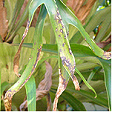 Staghorn Beetle Damage
Staghorn Beetle Damage
Staghorn Beetle (Halticorcus platyceryi) is a small rounded beetle that is black with four dull red spots on the wing covers. It has pinkish lava and both larvae and adult feed on the epidermal layer of fronds leaving small brownish sunken areas.
Wattle Blight (Paropsis orphana) adult is a light green oval-shaped beetle with white stripes on its wing covers up to 6mm long. The small lava has a tapering shape and both adult and lava feed together in groups on the surface of Acacia species leaves turning them brown.
Vegetable Weevil (Listroderes difficilis) is found during cooler weather (spring or autumn). The adult brown beetle up to 19mm long with a "V" mark on its back and the eggs are laid in the soil around the base of the host plant. The cream coloured lava emerges in spring after rain and feed on the lower leaves forming irregular holes or chewing holes in stems. The lava also feed on fleshy roots boring holes into carrots. Both the adults and lava cause damage, feeding on the plant during the night and resting at the base or under ground during the day. The lavae pupate in the soil over winter.
Life Cycle
This insect has a Holometabolous life cycle, i.e. it has a larval and a pupal stage.
Distribution of the Pest
Beetles are found world wide.
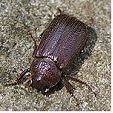
Period of Activity
The beetles are active from spring to mid summer preferring the warmer weather.
Susceptible Plants
The beetles attack many species of trees, shrubs, ferns and small plants as in potted plants in nurseries.
Anemone and Clematis species are attacked by the Black Blister Beetle (Epicauta pennsylvanica) which eats the leaves and flowers.
Callistephus species are attacked by the Asiatic Garden Beetle (Autoserica castanea) that chews on the foliage at night and hides in the soil or around the base of the plant during the day.
Carya species are attacked by the Bark Beetle (Scolytus quadrispinosus). The tiny adult beetle is brown up to 5mm long and the legless lava tunnel the bark and sapwood where it over winters, causing ringbarking. Twigs and small branches wilt and die.
This species is also attacked by the Twig Girdler (Oncideres cingulate), a reddish beetle that is 20mm long and produces small lava that girdles twigs by tunnelling, where it overwinters. This weakens the twigs causing them to snap off or results in ringbarking.
Cheiranthus species may be attacked by the Red Turnip Beetle (Entomoscelis americana) which is bright red with black markings in its head and wing covers and feeds on the foliage.
Eucalyptus species and other plants in the Myrtaceae family are attacked by the Flower Scarab Beetle (Protaetia species) a rounded brownish adult that grows to 20mm long, feeding solitary on flower pollen or new growth causing wilting and twig dieback. The insect is found from tropical to temperate regions and is regarded as a minor pest. Eucalyptus are also attacked by Leaf-eating Beetles which eat irregular pieces from the margins.
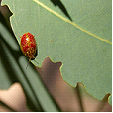 Damaged Margins on Eucalyptus by the Leaf-eating Beetles
Damaged Margins on Eucalyptus by the Leaf-eating Beetles
Protea species are also attacked by the Flower Scarab Beetle.
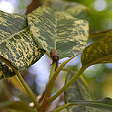 Ficus species
Ficus species 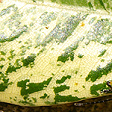 Damaged epidermal layer
Damaged epidermal layer
Ficus species are susceptible to the Fig Leaf Beetle (Poneridia semipullata). Both adult and larvae feed on the leaves eating the epidermal layer and making the plant in large infestations look poorly.
Ulmus species are attacked by the European Bark Beetle and the Leaf Beetle (Galerucella luteola) adult, which eats areas out of new leaves.
Ficus species are susceptible to the Fig Leaf Beetle (Poneridia semipullata). Both adult and larvae feed on the leaves eating the epidermal layer and making the plant in large infestations look poorly.
Samanea saman fruit pods are attacked when the burchid beetle (Merobruchis columbinus) oviposits in the immature fruit. The lava can kill or damage up to 75% of the seeds but is not commonly a major problem.
Solanum tuberosum is attacked by wireworm (Agriotes species). The larvae of this beetle, tunnels into the tubers. It is best controlled by planting in the soil which has not been affected previously.
Ulmus species are attacked by the European Bark Beetle and the Leaf Beetle (Galerucella luteola) adult, which eats areas out of new leaves and its lava skeletonise the underside of mature leaves later in the season.
Damage Caused
Some beetles and their larvae may eat the leaf surface in bands leaving the veins intact while other larger beetles tend to eat leaves from the margins preferring new shoots.
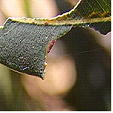 Beetle damage
Beetle damage
Cultural Control
Small infestations may be removal by hand where possible.
The Brown Eucalypt Beetle will not fly during the night and if disturbed by shaking or beating the tree, fall to the ground where they can be collected on a tarp that is laid under the tree then destroyed. This method also works on the Flower Scarab Beetle that fall to the ground pretending to be dead when disturbed.
Biological Control
Beetles are eaten by predators including birds, frogs, and lizards and are attacked by parasitic wasps.
Chemical control
Will vary with the pest, the plant on which it is found. The part of the plant being attacked.
Note
It is your responsibility by law to read & follow the directions on the label of any pesticide
Amendments by B. Sonsie Dip Hort Sc Burnley
PEST
NAME
Borer (General)
Various Borer Species
ORDER
Various
FAMILY
Various
Description of the Pest
Generally the larvae bore holes into the heartwood, sapwood or down the centre of twigs though not all borers attack trees. These tunnels may be small or large, deep or shallow and when they emerge from their tunnels at night, they feed on the surrounding tissue. Entrance holes may be covered by a layer of chewed wood fragments ("frass"), silk webbing or exposed and the tunnels may be solitary or form galleries. Certain species attack only twigs and young shoots, while others attack the trunk or roots.
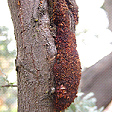 Fruit tree moth borer damage
Fruit tree moth borer damage
The adults female of a fruit tree moth borer normally deposits eggs in damaged areas of the bark or where there is and existing active site. The larvae vary but generally they are creamy to brown, thick soft grub-like reddish brown, and up to 40mm in length.
The adults are white, satiny moths with 40-60mm wingspans with their black abdomens fringed with orange-brown hair or beetle lava that has been deposited in the bark or twigs then tunnels the host.
American Plum Borer (Euzophera semifuneralis) lava is pinkish white to brownish green and attacks the inner bark and cambium region of the tree causing premature death. It is normally found on Platanus orFraxinus species and may also infest many species of fruit trees.
Apple Root Borer (Leptopius squalidus) female adult is a weevil to 20mm long and feeds on the leaves and the plump, legless grub-like lava feeds on the roots of the same host forming tunnels in the deep roots. It is commonly found on Acacia and Eucalyptus species damaging the anchorage of the plant.
Banksia Borer (Cyria imperialis) adult is a black beetle with yellow markings on its wing covers growing to 15mm long. The thickish legless lava is white, tapering from the head and forms flattened tunnels into the heartwood of the host.
Bronze Birch Borer (Agrilus anxius) is a bronze coloured beetle up to 14mm long and lays eggs in crevices in the bark. The legless white larva grows to 20mm long and feeds on the sapwood girdling the branch with flat irregular galleries.
Cedar Tree Borer (Semanotus ligneus) is a black beetle with orange and red markings on its wing covers and grows to 12mm long. The larva feeds on the sapwood of Sequoia, Thuja species and Pinus radiata with curved tunnels that may girdle branches.
Chestnut Borer (Agrilus bilineatus) adult is a tiny slender, blackish green beetle up to 8mm long emerging during spring. The small white larvae have a flat head and are up to 15mm long, forming galleries under the bark of Quercus species.
Cypress Bark Beetle (Phloeosinus cupressi) adult is dark brown with a blackish head, oblong in shape up to 3mm long. The tiny beetles tunnels under the bark of the host and deposits eggs. After hatching the tiny 4mm long, legless larvae bore into the heartwood damaging the tree. After they pupate in the tunnel they emerge through small round holes, commonly many together on the trunk. Damaged trees show signs of browning and dead leaves in the upper branches or falling damage twigs. Cupressus species are particularly vulnerable to attack.
Deodar Weevil (Pissodes nemorensis) is brownish with an obvious snout feeding on the cambium layer and deposits eggs in the bark of the leader and branches. The white lava tunnel the wood eventually killing the leader.
European Corn Borer (Pyrausta nubilalis) is a small moth that lays up to twenty eggs on flower buds. The young flesh coloured larvae mature to a reddish brown and each of its segment has four, spined dark spots.
Elephant Weevil (Orthorhinus cylindrirostris) is a grey or black insect up to 20mm long and lays eggs in the bark near the base of stressed trees. The larva tunnels its way through roots or trunks depositing frass as it goes, then emerging from a second round hole. The adults eat strips from the leaves, normally not bothering the plant.
Elm Borer (Saperda tridentate) adult is a greyish beetle with red bands and black spots on its wing covers and is up to 12mm long. The eggs are laid on the bark and the whitish lava tunnels into the bark and sapwood where it overwinters. It is normally found on Ulmus species.
Iris Borer (Macronoctua onusta) is born from a grey moth with a wing span up to 30mm across, and lays eggs that overwinter in old leaves and debris. As the leaves emerge the eggs hatch entering the leaves at the base, visually forming tunnels and growing to 30mm long. In the later season flower buds may be attacked. Both flowers and leaves eventually turn brown and die.
Lilac Borer (Podosesia syringae) adult is a wasp-like moth that produces pure white lava with a brown head that are up to 25mm long. It initially feeds in the sapwood causing wilting before tunnelling the hardwood making the branches brittle. Evidence of frass is found at the tunnel entrance and secondary fungal attacks infect the holes. Normally found on Syringa species.
Locust Borer (megacyllene robiniae) adult is a black beetle with golden spots, up to 20mm long and produces a small larva that tunnels galleries into the sapwood causing a blackish discolouration. Robinia species are normally attacked.
Mottled Borer (Cryptorhynchus lapathi) attacks Salix species. The adult beetle is black up to 10mm long and the lava bore into the surface of the stem causing swollen growth. Salix species are attacked.
Murry Pine Borer can be two species (Diaoxus erythrurus) and (Diaoxus scalaris). The adults are glossy green-brown beetles that are up to 20mm long and the white grub-like lava is legless, tapering from the head. They tunnel into the sap or hardwood of the trees forming connecting galleries causing ringbarking and creating brittle branches, commonly fond on Callitris species.
Peach Borer (Sanninoidea exitiosa) is a larva that tunnels roots causing gummosis that is mixed with frass at the crown just below soil level. The affected Prunus species produce yellowish leaves and grows poorly. There is another borer, Lesser Peach Borer (Synanthedon pictipes) which attacks any part of the plant from the trunk to the branches and is found on several Prunus species.
Puriri Moth (Aenetus Virescens) a New Zealand short lived moth that grows with a wing span of over 100mm (4in) wide laying eggs on the forest floor at night during spring. The caterpillars grow to 100mm long feeding on leaves and then ascending into the trees and entering the cambium layer up to 150mm deep forming a characteristic '7'-shape burrow that is concealed by frass. The caterpillar may live for 7-years before pupating and collectively they ring bark branches or trunks causing dieback.
Many New Zealand plants including Nothofagus solandri, Pomaderris spp.and ornamentals such as Quercus spp. Betula pendula, Salix spp. Populus spp. Acer spp. Citrus limon and Paulownia spp. are attacked. Control is difficult and generally the plants tolerate attack.
White Pine Weevil (Pissodes strobi) lava feed on the inner bark and sap wood of terminal shoots causing ringbarking and death of the shoot. The reddish brown beetle up to 6mm long is mottled in white and emerges during early summer then lays yellowish lava that are up to 9mm long.
Scribble Moth (Ogmorgraptis scribula) is a grey moth up to 0.4mm wide and produces a cream to brown larvae that is also about 0.4mm long and tunnels in the bark causing a scribble effect. This normally has no detrimental effect on the tree.
Spotted Hemlock Borer (Melanophila fulvoguttata) adult is a colourful metallic beetle with yellowish red spots on the wing covers and lays eggs in cracks in the bark. The white lava is up to 14mm long and forms galleries in the bark and sapwood of the host.
The large Swift Moth and Wood Moths can have a wing span up to 250mm wide and produce large larva that are grub like up to 150mm long, some with horny plates on the thorax. These larvae bore tunnels that are up to 30mm across straight through the heartwood of the host plant. The larvae may live in the tunnel for up to five years before pupating.
Red Cedar Bark Beetle (Phloesinus dentatus) is a small beetle up to 3mm long and lays its larva in excavations in the bark. When the larva emerges they bore galleries in the bark and tend to be more prevalent in stressed or recently transplanted plants.
Vegetable Weevil (Listroderes difficilis) is found during cooler weather (spring or autumn). The adult brown beetle up to 19mm long with a "V" mark on its back and the eggs are laid in the soil around the base of the host plant. The cream coloured lava emerges in spring after rain and feed on the lower leaves forming irregular holes or chewing holes in stems. The lava also feed on fleshy roots boring holes into carrots. Both the adults and lava cause damage, feeding on the plant during the night and resting at the base or under ground during the day. The lava pupates in the soil over winter.
Wattle Web-covering Borer (Cryptophasa rubescens) adult is a satin coloured moth that is up to 50mm across and deposits green fleshy lava that is up to 35mm long. The lava forms shallow tunnels in the bark and sap wood of the host and camouflages it with chewed wood and faeces that is webbed together. Commonly seen attacking the branches on Acacia species.
Life Cycle
These insects have normally have a Holometabolous life cycle. But some borers such as Termites have a Hemimetabolous life cycle.
Eggs are laid singly or in groups, in damaged areas of the bark and branch. Larvae shelter in tunnels they create in the wood and some species may take many years to pupate and emerge as an adult. This may take place in live or dead wood. Other species such as Corn Borer can have up to two generations per year.
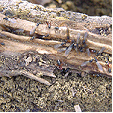 Termites and their damage
Termites and their damage
Distribution of the Pest
Borers are found throughout the world with many species found in Australia both on the coast and inland.
Period of Activity
Varies with the insect concern. Many larvae can be active for many months. Termites are active all year.
Damage Caused
Most damage appears on branches or trunks where the larvae feed on the soft tissue and extensive feeding may cause ring-barking. Normally plants survive borer attack but repetitive attack will cause the death. Certain species are a serious pest in plantations or monocultures such as the Pine Bark Weevil, and the Sirex wood wasp.
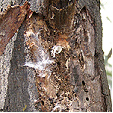 Typical borer damage by a moth larva
Typical borer damage by a moth larva
Chestnut Borer feeds on the sap wood ringbarking large branches and overwinters in the tunnels.
Corn Borer feeds on flower buds and leaves resulting in there death, after which the larva tunnel down the stem causing wilting. There are many crop plants and ornamentals that are affected by this larva.
Swift Moth and Wood Moths weaken trees by boring large tunnels through the branches that may not be noticed until holes are cut through the bark during emergence.
Iris Borer damages leaves to turn brown and wilt, flowers also turn brown and with the aid of a bacterial rot, collapse and die. This damage may be extended to the flower stalk.
Stem Borer (Papaipema nebris) is a small lava to 12mm long, and attacks many garden plants including Lilium, Aster, Alcea and Phlox species
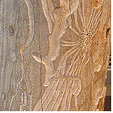 Borer Damage
Borer Damage 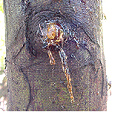 Resin oozing from a trunk
Resin oozing from a trunk
Susceptible Plants
There are many plants that are attacked by these pests including Banksia, Callistemon, Melaleuca, Lagerstroemia, Jacaranda species, and flowering stonefruit. Eucalyptus, Acacia species and many ornamental such as Acer species. Plants that are stressed, are particularly venerable.
Acacia and Eucalyptus species are attacked by Swift Moths and Wood Moths.
Acacia species are susceptible to attack from the Wattle Web-covering Borer (Cryptophasa rubescens), which weakens and causes die back of branches.
Acer platanoides is attacked by the Leaf Stalk Borer (Nepticula albostriella) that tunnels into the petiole of the leaf turning it blackish and also attacks the fruit.
Acer saccharinum is attacked by the Petiole Borer (Caulocampus acericaulis) which tunnels in the petioles. It generally attacks the leaves on the lower branches causing them to fall.
Acer species may also be attacked by several borers including the Flat Headed Borer (Chrysobothris femorata), a 25mm long lava of a coppered coloured beetle, that tunnels galleries under the bark girdling the trees The Sugar Maple Borer (Glycobius speciosus) which girdles branches killing them and the Leopard Moth (Zeuzera pyrina) lava that tunnels large holes into branches making them structurally weak. This lava can grow to 80mm long and 12mm thick overwintering in the tunnels.
Banksia species are attacked by the Banksia Web-covering Borer (Xylorycta strigata) a greenish lava up to 40mm long that tunnels down the centre of branch tips. The entrance is covered in silken web littered with faecal material and causes the death of the branchlets.
Betula and Populus species are attacked with the Bronze Birch Borer (Agrilus anxius) and heavy infestation may kill the tree. Populus species are also attacked by the Poplar Borer (Saperda calcarate).
Brachychiton species are attacked by the Kurrajong Weevil (Axionicus insignis) the lava of this plump greyish weevil is white and legless, entering the plant through wounds forming rounded tunnels that may girdle the tree, killing it.
Carya species are attacked by the Painted Hickory Borer (Megacyllene caryae). The adult dark brown beetle has obvious zig zag lines on its wing covers and the lava is cream coloured, both up to 20mm long. The lava tunnels the sapwood of living trees causing ring barking and also tunnels dead trees.
Cornus species are attacked by several borers such as the Flat Headed Borer (Chrysobothris femorata) and the Dogwood Borer (Thamnosphecia scitula).
Cupressus species are attacked by the Cypress Bark Beetle (Phloeosinus cupressi) causing the branches to turn brown and die off from the top or causing the leaves to wilt. On first indication of infestation selective prune off damaged areas or remove the tree.
Hakea sericea and other Hakea species are attacked by the Web-covering Borer (Neodrepta luteotactella). The larvae bore into the twigs and fruit forming a small covering of frass. This insect also infects Macadamia species. Hakeas are also attacked by several other web-covering borers.
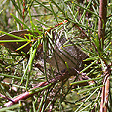 Hakea sericea
Hakea sericea
Pinus and Picea species are attacked by the White Pine Weevil (Pissodes strobi) in the northern hemisphere.
Samanea saman is attacked by the borer (Xystrocera globosa) which chews into the sap wood of stressed trees and can cause serious damage.
Sorbus aucuparia is attacked by the Round Headed Borer (Saperda candida) which forms galleries in the trunk at ground level, forming round holes in the bark.
Tilia species are attacked by the European Bark Borer (Chrysoclista linneela), which feeds on the bark and thew Linden Borer (Saperda vestita) that attacks the base of the trunk or roots.
Tsuga species are attacked by Spotted Hemlock Borer (Melanophila fulvoguttata).
Vaccinium ovatum is infested by the Azalea Stem Borer (Oberea myops). The yellowish lava of this beetle bores into the tips of stems during the flowering period and is up to 12mm (½in) long. It is also commonly found on Rhododenron species.
Control
Cultural Control
Larvae may be destroyed after exposure by pulling away the covering pad of frass, or by pushing a length of wire into the tunnel. Damaged branches may be removed. Improve the culture by feeding and watering the plant.
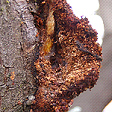 Frass due to the Fruit tree moth borer
Frass due to the Fruit tree moth borer
Biological Control
No effective biological control though certain species of trees exude gum or resin sealing the holes and limiting the activity of the larvae or causing its death.
Chemical Control
There is no satisfactory chemical control most borers of live wood.
Note
It is your responsibility by law to read & follow the directions on the label of any pesticide
PEST
NAME
Bugs (General)
Various Bug Species
ORDER
Hemiptera
Description of the Pest
Generally bugs are sap sucking insects with a strong proboscis and are commonly shield shape. They may be dull grey-brown or brightly coloured with long anatine and legs. They feed in colonies or solitary and cause excessive damage due to the toxic saliva they inject into the plant. They also are capable of emitting a nauseous smell or squirting a caustic fluid when disturbed or they fly away. Both adults and nymphs have piecing and sucking mouthparts and adults commonly shelter under plant litter or under bark during winter.
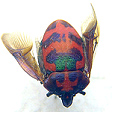
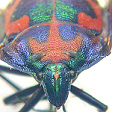 Cotton Harlequin Bug (Male)
Cotton Harlequin Bug (Male)
Cotton Harlequin Bug (Tectocoris diophthalmus) adult female is up to 20mm long and is orange-yellow with black patches on its wing covers. The smaller male is reddish with bright metallic blue or green markings. Eggs are laid in a spiral arrangement around twigs and both eggs and nymphs are guarded by the adult female.
Adults and nymphs have piercing and sucking mouthparts and cause little damage to the host plant, though may be found in large numbers. They appear during late winter and are more prevalent along coastal regions on plants from the Malvaceae family such as Lagunaria patersonii. Control is not normally warranted.
Crusader Bug (Mictis profana) is a light brown elongated bug to 20mm. It has distinctive pale yellow cross mark, depressed on its back and large rear legs. It has long antennae that are tipped in yellow and when disturbed can secrete a foul smelling caustic fluid. The immature stages (nymphs) are brownish with no cross and marked with two small orange spots on the abdomen.
Both adult and nymph have piecing and sucking mouth parts and are solitary feeders on tender new shoots causing wilting and dieback. They are found on a wide range of plants including Hibiscus and Acacia species and normally do not require control.
Eucalyptus Tip Bug (Amorbus alternatus) adult is a blackish shield-shaped insect up to 20mm long with a spine on each shoulder. The wing covers are marked with a yellowish 'V' pattern and the lava are brightly coloured in shades of blue and orange with its body tapering towards the head.
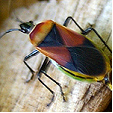 Harlequin Bug
Harlequin Bug
Harlequin Bug (Dindymus versicolor) is very colourful with red or black upper parts and a green to yellowish abdomen and is up to 12mm long. The wingless nymphs are also brightly coloured and are commonly found in temperate climates on plants and structures such as fences. .
There is also another Harlequin Bug (Murgantia bistrionica) that is found in North America and has simular colourings, habits and grows to 10mm long. The adult lays eggs in double rows on the underside of leaves.
Metallic Shield Bug (Scutiphora rubromaculata) is up to 10mm long. The adult is brightly coloured in metallic blue with two obvious red blotches on its thorax. It is found in tropical to sub tropical regions.
Plant Bug (Hallicotoma valida) is small and blue-black, which slightly engraves the epidermal layer of the leaf turning it yellow and is found on Yucca species.
Rutherglen Bug (Nysius vinitor) is dull grey with silvery wings that up to 5mm long and the winged nymphs are also grey.
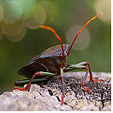 Bronze Orange Bug
Bronze Orange Bug 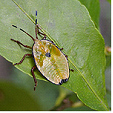 Bronze Orange Bug Nymph
Bronze Orange Bug Nymph
Appearance and Distribution of the Pest
Generally nymphs appear in winter after hatching from eggs that were laid in late summer under the leaves, generally unnoticed apart from a strong smell.
They are found throughout the world in tropical, sub tropical to temperate regions. They appear from late winter to late autumn and can be seen on the new growth and fruit.
Rutherglen Bug can form large colonies causing the new growth to wilt or stem tissue forms a dry area. It can become a serious pest requiring control.
Life Cycle
These insects have a Hemimetabolous life cycle, ie. When the immature nymphs resemble the adults.
There are five nymphal stages with the eggs laid during late winter and up to 4 generations each season. Certain species of adults tend the eggs until they hatch. The insect over winters as an adult.
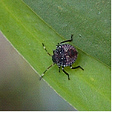
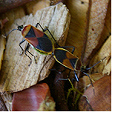 Harlequin Bug
Harlequin Bug
Period of Activity
This pest is active throughout spring and summer, with large numbers occurring in autumn.
Damage Caused
Generally the nymphs and adults feed on new shoots, the underside of leaves, flowers and stems of plants and mature bugs feed on fruit or seeds. This causes bean pods to become shrivelled and distorted, or tomatoes form mottled areas and peaches exude clear gum. Leaves and flowers wilt or shrivel and die. The North American Harlequin Bug forms white or yellow blotches on the leaf surface causing plants to wilt and die.
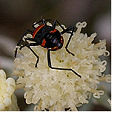
Susceptible Plants
There is a wide range of plants that are attacked by various bugs including legumes such as beans or lucerne or pumpkin, spinach, passionfruit and many ornamental and native trees and shrubs. Fruit trees and weeds are also attacked.
Abutilon, Alyogyne, Hibiscus species, Vitis vinifera (grape) and Lycopersicon esculentum (tomato) are susceptible to attack by Harlequin Bug (Dindymus versicolor) causing damage to new growth and blemishing fruit with there excrement. Many vegetables and fruit trees are also susceptible to attack.
Abutilon, Alyogyne, Hibiscus species are also attacked by the Cotton Harlequin Bug (Tectocoris diophthalmus).
Eucalyptus species are attacked by the Eucalyptus Tip Bug (Amorbus alternatus). The slow moving adults suck sap from the host solitary or in groups causing wilting and sometimes dieback of the branches. It is not regarded as a major pest and control is not normally required.
Ficus and Melaleuca species are attacked by the Metallic Shield Bug (Scutiphora rubromaculata).
Acacia, Cassia, Citrus, Hibiscus, Senna species and Vitis vinifera are susceptible to attack by the Crusader Bug (Mictis profana) damaging new shoots.
Leucanthemum species are attacked by the Four-lined Leaf Bug (Poecilocapsus lineatus). The adult is yellow with four black stripes on its wings and attacks the leaves causing spotting that turns them brown, eventually dieing.
Pennisetum clandestinum (Kikuyu) is attacked by the Billbug (Spenophorus brunnipennis). This weevil produces larva that can be seen at the soil level and are legless up to 10mm long with a brown head and a cream coloured curved body. During early summer affected leaves turn yellow and a second generation may occur in late summer.
Bluegrass Billbug (Sphenophorus parvulus) attacks Poa pratensis (Kentucky Bluegrass).
Cultural Control
Small infestations may be carefully removed by hand or hosed off then collected. Heavily infested plants or plant parts may be removed and destroyed. Weed control around the plants may increase possible infestation as the bugs migrate to a new host. A barrier of annuals may be planted around susceptible plants as to attract the bugs once the annual weeds die off.
Remove all rubbish such as woodpiles or garden wast or rubbish from the garden as bugs tend to shelter in these areas. Susceptible plants may be sprayed up to three times during the cooler months with a soapy or glue spray on both sides of the leaves in order to kill the nymphs.
Hosing may also dislodge adult bugs and once on the ground they can be squashed. Another novel method for removal is to use an electric or portable vacuum cleaner to suck the bugs from the host plant. This method is excellent on several species including stink bugs and Christmas beetles.
Biological Control
Bugs are attacked by many predators including; birds, spiders, assassin bugs, parasitic wasp and parasitic fungi. These predators combined still have little control over infestation of susceptible plants.
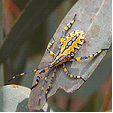 Assassin Bug Nymph
Assassin Bug Nymph
Chemical Control
Spraying with insecticides is effective, such as Fenthion, Maldison or Dimethoate. Always read the label for registration details and direction of use.
Note
Always read the label for registration details and direction of use prior to application of any chemicals.
PEST
NAME
Ants (General)
Various Species
ORDER
Hymenoptera
FAMILY
Formicidae
Description of the Pest
Ants are socially organized, living in colonies that can be found underground, in logs or in ant hills. Ant colonies normally consist of three castes, female, male and sterile workers. The queen lays eggs and is winged until it mates. The males are winged and seek females to mate with. A colony may have only one queen, or there may be many queens depending on the species. Ants are easily recognised by a swollen node at the end of a long narrow waist, (waist) or by there elbowed antennae. Ants may also have more than one nest and workers form trails or tunnels, over some distance to service the colonies. Many species of ants have poison sacks &/or stingers in for defence against their many predators. Ants vary in length from about 1 to 30 mm & are typically black, brown, red, yellow or a combination of these colours.
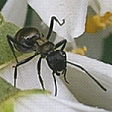
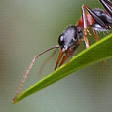 Elbowed antennae
Elbowed antennae
Note
There are many species of ants and it should be recognised that ants can be beneficial as well as a pest. There are only a few species that damage plants or turf.
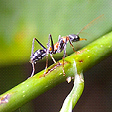
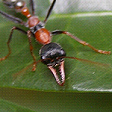 Ant Jaws
Ant Jaws
Red Bulldog Ant (Myrmecia gulosa) is large and primitive, having a less complicated social organization. They are also fighters (pugnacious) and have large mandibles that can bite causing a painful sting.
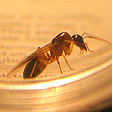 Winged Queen
Winged Queen 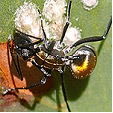 Queen Golden Spiny Ant
Queen Golden Spiny Ant
Golden Spiny Ant (Polyrachis ammon) is a medium size insect with a black body and marked with a bright golden patch on the back of the thorax and abdomen. They also have four spines on the thorax and node.
Argentine Ant (Linepithema humile) is a tiny brown ant to 3mm long and has become a pest in many areas feeding on a variety of materials and is easily recognised as it travels along defined trails.
Black-headed Sugar Ant (Camponotus nigroceps) is a large ant with a reddish thorax and legs and a black head. The queen is winged and its bite has no sting.
Honey Pot Ant (Camponotus inflin) is small and some workers are stuffed with food until they cannot move and are used as a living food container.
Life Cycle
Ants have a complete metamorphosis (Holometabolous egg, larva, pupa and adult). The queen remains in a chamber and deposits eggs, nests may have more than one queen. The legless lava emerges and is feed by workers until they enter the pupal stage. After pupating they become worker ants, males or future queens. Workers tend to the colonies needs, such as constructing tunnels, collecting food, looking after the queen and eggs. They also defend the nest.
Ants overwinter in all stages of the life cycle in there nest.
Distribution of the Pest
Ant activity is found throughout the year in tropical regions but is more active during the warmer months in temperate regions. They are distributed by the adults flying to new areas to form colonies and are transported in infested pots or other materials such as turf sods.
Period of Activity
All year
Damage Caused
Ants cause plant damage in several ways, such as chewing on leaf margins causing minor damage or collecting and destroying seeds. Ants have formed many associations with insects which produce honey dew such as Aphids, leaf hoppers and some scales and lerps, and can interfere with biological controls.
Ants are predators of many insects and larvae such as caterpillars. A balance is required depending on the species of the plant under attack and in the garden ants should be left alone.
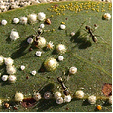 Ants tending Lerps
Ants tending Lerps 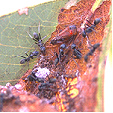 Ants tending Mealybugs
Ants tending Mealybugs
Potted plants commonly have nests established in the base of the pot and disrupt water saturation of the soil.
Funnel Ants (Aphaenogaster species) cause turf grass to die by removing the soil around the roots and creating mounds above soil level. These nests restrict the available water to the roots and have a simular affect as a drought.
Fire Ants (Solenopsis invicta) are a serious pest of agriculture and horticulture as they attack and sting repetitively after being disturbed creating problems for people in the field.
Susceptible Plants
There is a wide range of ornamental plants such as Wattles that become infested with ants and are associated with insects that produce honey dew.
Container plants or indoor plants are commonly infested resulting in a decline of vigour.
Samanea saman is attacked by (Myrmelachista ramulorum), an ant that defoliates and deforms leaves by burrowing into the twigs.
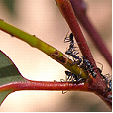 Ants on Eucalyptus species
Ants on Eucalyptus species 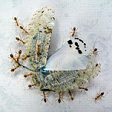 Ants eating insect
Ants eating insect
Control
Cultural Control
Young or sensitive trees may be banded with sticky traps, glue or grease to inhibit the access of ants tending other sap sucking insects and allowing natural predators such as ladybirds to control insect infestations. Weed control under trees or the removal of debris and food scraps also reduces ant infestations. Container plants can be emersed in water to rid them of ants.
Biological
Ants are an important component of the ecosystem and although a wide range of animals feed on ants none are commercially available.
Chemical Control
There are various chemical methods to deter ants, such as poring turps into the nest or spraying a mixture of kerosene and detergent around the nest. Ants may also be sprayed with a contact insecticide.
Baits can be used to control ants
Note
It is your responsibility by law to read and follow the directions of any pesticide
Monitoring
Pitfall traps
Amendments by B. Sonsie Dip Hort Sc Burnley
PEST
NAME
Spittle Bugs, Cuckoo Various Species
ORDER
Hemiptera
Description of the Pest
Generally Cuckoo spit bugs are small beetle-like or cicada shaped insects up to 10mm long and have soft greyish bodies. They produce a frothy secretion that covers the young for protection and stops them from drying out. Both adult and nymph have piercing sucking mouth parts. The adults are capable of jumping when disturbed and are commonly known as 'froghoppers'.
Common Cuckoo Spit (Philagra parva) is brown and small up to 4mm long with a pointed head. The soft nymphs are brown and produce white froth.
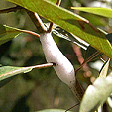
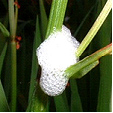
Cuckoo Spit (Bathylus albicinctus) are a small brown beetle-like insect up to 5mm long and has larvae that cover themselves in white froth.
Appearance and Distribution of the Pest
They are found during the warmer months in temperate climates and throughout the year in sub-tropical to tropical regions. They spread by flying.
Life Cycle
These insects have a Hemimetabolous life cycle, ie. When the immature nymphs resemble the adults.
Damage Caused
The insects feed off the plant and are found in the leaf axils, normally not affecting the plant.
Susceptible Plants
There is a wide range of plant attacked by this insect including Casuarina, Acacia, Grevillea and Baeckea species.
Cultural Control
The insects may be hosed off but generally control is not required.
Biological Control
Birds and other predators keep the numbers down.
Chemical Control
Not normally necessary.
DISEASE
NAME
Sooty Mould
Various Sooty Mould Species
Description
A fungal problem related to honeydew that is secreted from other insects. The fungus will not infect the host plant.
Symptoms
A soot-like dry black fungus appears on areas of the plant where honeydew is found. The fungus spreads and becomes thick restricting the plants capability to photosynthesize. The fungus can also appear on fruit spoiling its appearance and gives the plant an unattractive look.
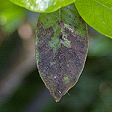
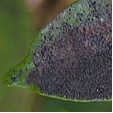 Gardenia augusta
Gardenia augusta
Source and Dispersal
It is found on other infected plants and soon spreads by wind to other susceptible plants.
Favoured Conditions
It is occurs when insects are producing honeydew, normally through the growing period.
Affected Plants
These fungi can found on most plants particular plants that are infected with scale insect that produces honeydew.
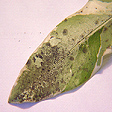 Pittosporum eugenioides
Pittosporum eugenioides 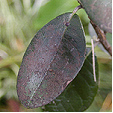 Camellia japonica
Camellia japonica
Callicarpa species are infected with Black Mould (Meliola cookeana) with its black mycelium growing on all parts of the plant including twigs and leaves.
Non-chemical Control
To reduce sooty mould it is required to controlling insect numbers on the plant. Affected plants may have the dry sooty mould rubbed or hosed off.
Chemical Control
Fungicides are not required, but the control of the insect producing honeydew is required.
Note
Always read the label for registration details and direction of use prior to application of any chemicals.
DISEASE
NAME
Fungal Gall of Wattles
Uromycladium species
Description
These fungal diseases may be specific to a particular host forming galls that vary in size up to several centimetres across. Old galls may be inhabited by insects.
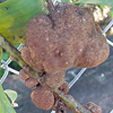
Symptoms
This fungus may attack phyllodes, leaves, pods, stems and branches depending on the species of the host and the fungus. Hard irregular brown knob like structures, appear on the outer stems of the crown and the developing fruits. They have a rusty colour with a granular texture.
Source and Dispersal
The fungus is spread by infested plants and the spores are distributed by wind.
Favoured Conditions
It prefers plants that are under stress ie. Growing on poor soil or in an exposed position and when the tree becomes senile.
Affected Plants
Acacia species.
Non-chemical Control
Prune off any infected parts of the plant and destroy. Fertilize and water the plant ot improve vigour.
Chemical Control
There is no satisfactory chemical control of this disease.
Average Lowest Temperature : -3º C 27º F
USDA : 9, 10
This USDA (United States Department of Agriculture) hardiness zone chart can be used to indicate a plant’s ability to withstand average minimum temperatures. However, other factors such as soil type, pH, and moisture, drainage, humidity and exposure to sun and wind will also have a direct effect on your plant’s survival. Use this chart only as a guide, always keep the other factors in mind when deciding where, when and what to plant.
A plant's individual USDA zone can be found in the Plant Overview.
Region of origin
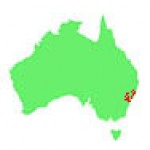
Australia, (New South Wales)
Climate Description
Warm Temperate
This zone has the majority of rain during winter in the west and summer in the east with high humidity. Summer temperatures may peak at 40ºC (104ºF).
Frost and drought mainly occur inland and coastal wind is normally accompanied with rain.
Plant growth
Wide range of native and exotic plants grow well.
| Dictionary | Growth Habit |
| Leaf Type | Botanic Flower Description |
| Leaf Shape | Flower Inflorescence |
| Leaf Arrangement | Fruit Type |
| Leaf Margin | Bark Type |
| Leaf Apex And Bases | Flower Description |